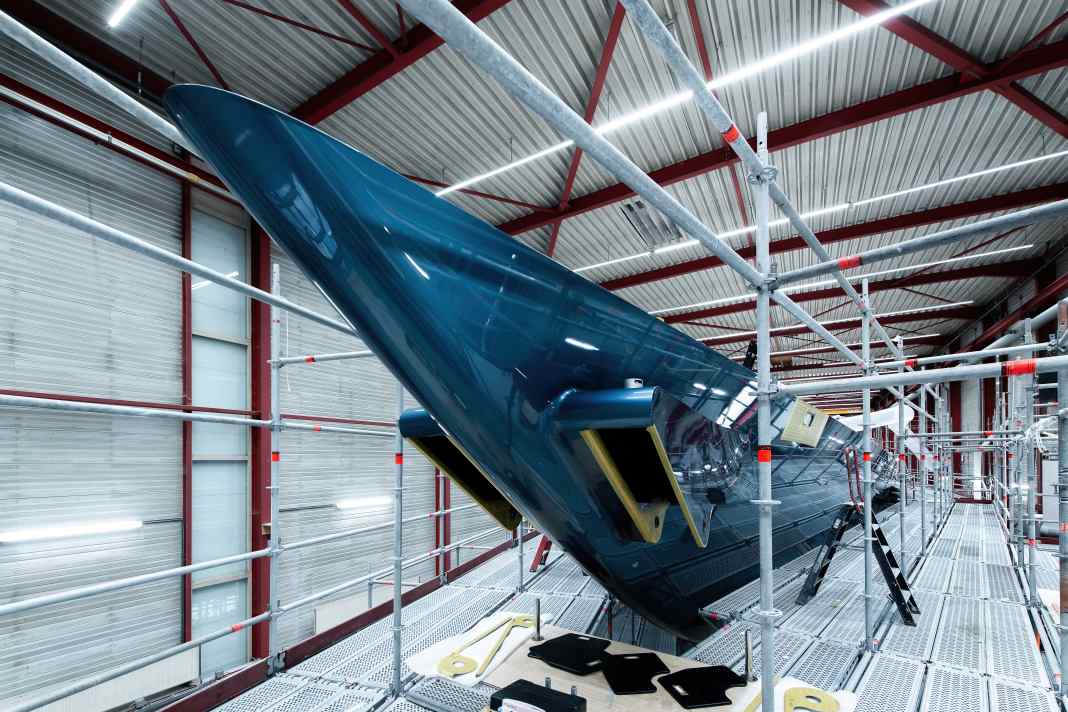





It is still not certain when exactly "Project Zero" will move freely across the seas. But new visualisations by Dutch design studio Vripack show what the 69-metre ketch will look like. Foundation Zero, the foundation behind the pioneering project, has also announced when it will leave the Vitters halls in Zwartsluis, the Netherlands, and enter the water: By the end of 2025, it will be the world's first supersailer to operate completely without fossil fuels. To achieve this goal, 60,000 hours of research and development work have gone into the project. Vitters utilises many technologiesthat have not yet made it onto yachts in this form.
"Zero" simply has to endure a lull
It is no coincidence that "Project Zero" sails through virtual space in light winds. Only the energy that is available at that moment is available. You can't start a diesel generator because there isn't one. If the batteries are empty or their energy is needed for on-board or sailing systems, then the long and narrow propeller blades of the rear electric pod drive do not help out with propulsion. It "has" to be sailed or simply steamed.
This can also become a lesson in boredom on 69 metres if, for example, strict power-saving requirements restrict access to Starlink. Endure and enjoy the peace and quiet. However, Dykstra's designers adapted the routing and dimensions of the rig so that it rarely happens or "Zero" stays in harbour when the wind forecast is poor. Fast sailing in all conditions becomes a necessity in order to keep the auxiliary drive idle or to generate power.
Battery bank instead of diesel generators
The centrepiece of "Zero" is an energy storage system with five megawatt hours. This capacity is roughly equivalent to 88 Tesla vehicles and should enable complete energy independence without diesel or generators. The power supply comes exclusively from renewable sources. Under sail, the main focus is on recuperation: from a speed of eight knots, the front propeller turns and the pod's electric motor becomes an electric generator that produces up to 250 kilowatts of electricity.
A total of 100 square metres of solar modules are used for photovoltaics and solar thermal energy, while a wind turbine is intended to provide additional power. It remains to be seen whether the system can meet the energy needs of a superyacht in practice. Supplying the hotel loads in particular could pose a challenge, with "Zero" focussing primarily on savings. True to the motto: "It makes no sense to generate something you don't need."
Lengthy trials follow watering
"This project was always about showing what is possible," says Marnix Hoekstra, Creative Co-Director at Vripack. "We wanted to show that comfort, design and performance can go hand in hand with fossil-free operation. The project was driven by data, testing and a long-term commitment to sustainable marine design. Our aim was not only to prove that a fossil-free superyacht is feasible, but also to create a real-life model for others to learn from."
After the technical launch of "Zero", as the yacht's name suggests, the teams will begin commissioning the advanced systems and setting the masts. The aluminium ketch will then undergo extensive trials to test the new technologies and sophisticated software that will control all aspects of performance.
Open source approach: From "Zero learn
In the interior, "Zero" uses innovative and sustainable materials: leather made from pine bark instead of animal products, marble with visible veins instead of polished surfaces and works by local artists in the cabins for up to twelve guests.
A central pillar of the project is the dissemination of technical expertise. All system data, findings and key components are to be made freely accessible via the FoundationZero.org platform. This allows others to use and further develop the technologies. This open source approach is unusual in the yachting industry and could accelerate the spread of sustainable technologies. Its success depends on its suitability for everyday use.
Seven years from the idea to delivery
"The project is not about showing how good we are, nor is it specifically about the yacht itself," says Eduard van Benthem, Executive Director at Foundation Zero and an experienced technical project and engineering manager in the yachting industry. "We are really trying to show how we can do things better and inspire others to join us on the journey, learn together and share the knowledge, which is the fundamental goal of Foundation Zero in all its projects."
In addition to private use, selected charters are organised where guests can experience the implemented technologies in action and subsequently retrofit their yacht or take them into account when building a new one. Zero" will also serve as a platform for scientific research at sea and support studies on renewable marine technologies and the sustainability of the oceans.
The 69-metre ketch is expected to be delivered in 2026 - more than seven years after the original idea.

